In southwest Nebraska, irrigating corn and soybeans with limited water is challenging due to typically dry weather conditions and high crop water use (i.e., evapotranspiration or ET) in July and August. (Evapotranspiration is the water lost to the atmosphere from both evaporation from any surface and transpiration from green vegetation.) In addition, declining groundwater levels, water allocations, frequent droughts, limited irrigation well capacities, and light-textured soils often prevent southwest Nebraska farmers from irrigating summer crops enough to meet their full crop water requirements.
Implementing alternative spring-planted crops such as chickpeas and field peas in the irrigated crop rotations (Figure 1) may provide benefits such as:
- more efficient use of spring precipitation;
- ability of the irrigation system to better align with the existing capacity and meet the peak ET demands of both winter and summer crops, especially if grown under the same irrigation system; and
- increased crop water use efficiency (CWUE; grain produced per unit of ET) and profitability of annual cropping system.
The objective of this project was to investigate the feasibility of field pea and chickpea production under irrigation and evaluate their potential for water conservation in irrigated cropping systems. Specifically, our goal was to quantify the grain yield and CWUE of field peas and chickpeas under different irrigation levels.
Study Approach and Treatments
The field experiment was conducted during the 2018 growing season at the Henry J. Stumpf International Wheat Center near Grant. The following irrigation treatments were applied to chickpeas and field peas:
- dryland (DRY, no-irrigation applied),
- deficit irrigation (DI), and
- full irrigation (FI).
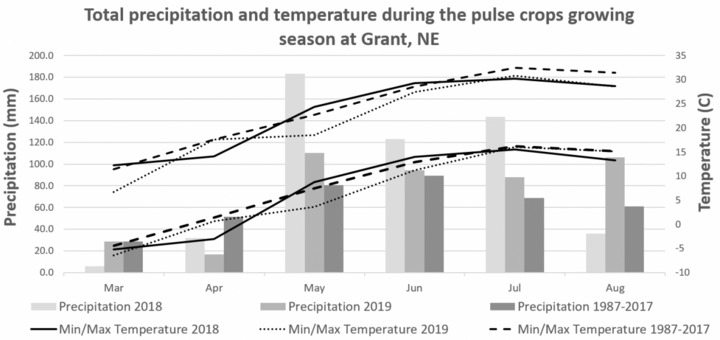
(Below) The research site is near Grant in southwest Nebraska in an area that receives 16-20 inches of precipitation annually.
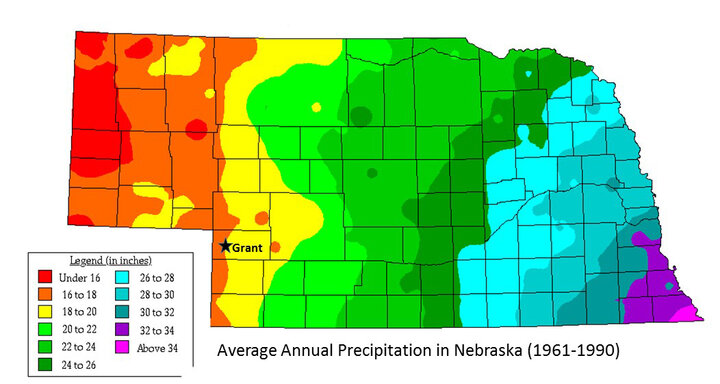
Soil moisture was measured using neutron attenuation down to a 5-foot depth to schedule irrigation and quantify changes in stored soil water. ET was calculated using the soil water balance, which is the summation of irrigation (I), precipitation (P), deep percolation (DP), and seasonal soil water change (SWC).
In 2018, field peas were planted on March 14 and harvested on July 16, while chickpeas were planted March 24 and harvested August 17. In 2019, field peas were planted on March 28 and harvested on July 17, while chickpeas were planted April 23 and harvested August 10.
Predominant soil type at the research site was Kuma silt loam with approximate plant-available water capacity of 2.2 inches per foot. The previous crop was wheat and soil was near field capacity at the time of planting. Growing season precipitation (March-August) in 2018 and 2019 was 5.7 and 2.5 inches higher than the 30-year average, respectively (Figure 2).
Results
Yield Response and Water Use
Field peas used less water, had better overall yield, and higher CWUE than chickpeas. For example, during the 2018 growing season, dryland chickpeas used 16.7 inches of water to produce 53.5 bu/ac yield, while field peas produced similar yield (55.5 bu/ac) using 3 inches less water (13.7 inches).
Field pea response to irrigation resulted in higher crop water use and increased yield. For instance, a yield increase of 4-5 bu/ac was observed in field peas grown under deficit irrigation (1.8-2.3 inches). Supplementing an additional 1.8-2.3 inches of water under full irrigation provided minor to no increase in crop yield over the deficit irrigation treatment in both 2018 and 2019 growing seasons (Table 1; Figure 3).
In contrast, irrigating chickpeas resulted in a yield decrease (Table 1, Figure 3). In 2018, chickpea yield under deficit irrigation (2.2 inches applied) and full irrigation (4.4 inches applied) was 16.5 bu/ac and 28.5 bu/ac yield less than dryland, respectively (Table 1; Figure 3). Chickpea yield (and ET) in 2019 was severely hampered by a high infestation of Ascochyta blight, regardless of the irrigation treatment.
Negative yield response to irrigation is not common in plants, especially if it’s coupled with increased plant water use; however, it is possible for irrigation to influence other yield-limiting factors. In our study, such response may be attributed to the increased incidence of Ascochyta blight.
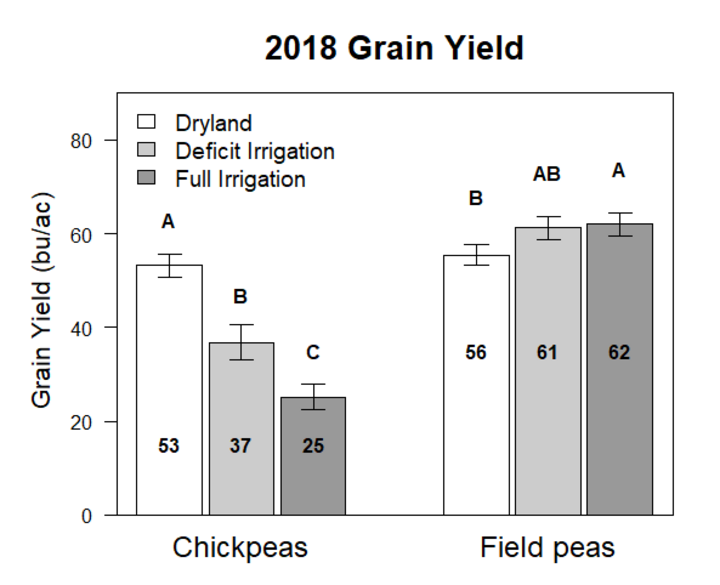

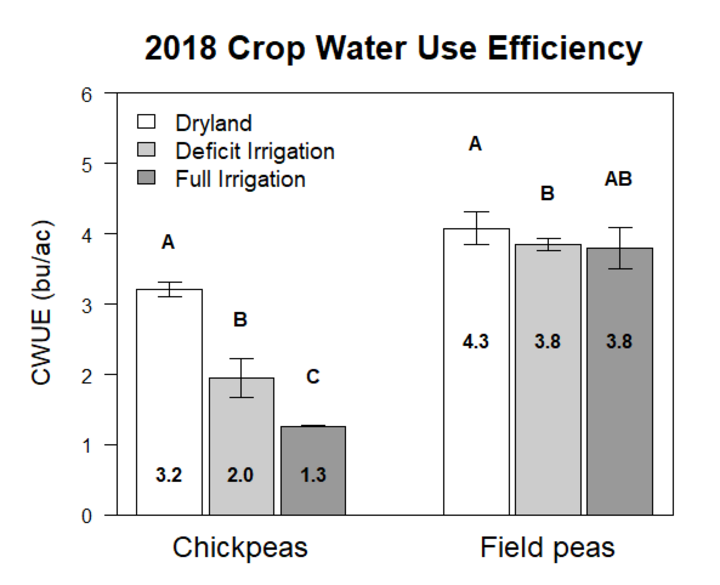

Figure 3. Average grain yield (bu/ac) and crop water use efficiency (CWUE) ± standard error (error bars) for chickpeas and field peas under dryland, deficit, and full irrigation during the 2018 and 2019 growing seasons in Grant. (Values within each crop with the same letter, A and AB, are not significantly different (ns) at a 95% confidence level.)
| Crop | Irrigation | P (in) |
I (in) |
RO (in) |
DP (in) |
ET (in) |
SWC (in) |
Yield (bu/ac) |
CWUE (bu/ac-in) |
|---|---|---|---|---|---|---|---|---|---|
| Field peas 2018 | |||||||||
| Dryland | 15.7 | 0 | 0 | 2.8 | 13.7 | -3.8 | 56 | 4.08 | |
| Deficit | 15.7 | 1.8 | 0 | 3.1 | 16.0 | -3.1 | 61 | 3.85 | |
| Full | 15.7 | 3.6 | 0 | 4.0 | 16.5 | 0.8 | 62 | 3.80 | |
| Chickpeas 2018 | |||||||||
| Dryland | 19.6 | 0 | 0.1 | 4.2 | 16.7 | -1.4 | 53 | 3.21 | |
| Deficit | 19.6 | 2.2 | 0.1 | 3.0 | 19.0 | -0.1 | 37 | 1.95 | |
| Full | 19.6 | 4.4 | 0.1 | 4.6 | 19.9 | -1.5 | 25 | 1.26 | |
| Field peas 2019 | |||||||||
| Dryland | 11.9 | 0 | 0 | 2.1 | 13.5 | -3.2 | 55 | 4.06 | |
| Deficit | 11.9 | 2.3 | 0 | 1.2 | 14.4 | -2.7 | 59 | 4.45 | |
| Full | 11.9 | 4.4 | 0 | 1.5 | 15.4 | -1.1 | 57 | 3.70 | |
| Chickpeas 2019 | |||||||||
| Dryland | 11.2 | 0 | 0 | 2.6 | 9.9 | -1.4 | 8.4 | 0.85 | |
| Deficit | 11.2 | 0.8 | 0 | 3.1 | 10.5 | -1.3 | 6.6 | 0.63 | |
| Full | 11.2 | 1.6 | 0 | 1.7 | 10.7 | -2.1 | 5.9 | 0.55 | |
Patterns in Soil Water Extraction
Field peas effectively utilized soil water available in the profile, especially under dryland conditions where water extractions were observed up to a four-foot depth (Figure 4). Irrigating field peas with 3.8 inches (i.e., full irrigation treatment) resulted in recharge of water deeper in the soil profile (Figure 4).
Chickpea soil water extraction was similar under dryland and irrigation with most of the soil water depletion occurring in the top 2.5 feet of the soil profile (Figure 4). Soil water recharge below the three-foot depth occurred in both dryland and full irrigation treatments and can be attributed to combined effects of abundant precipitation and slow crop development early in the spring (Figure 4).
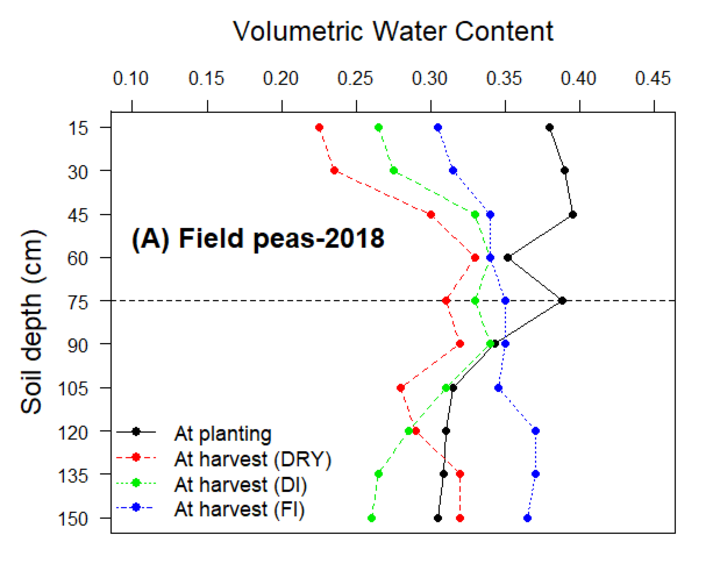
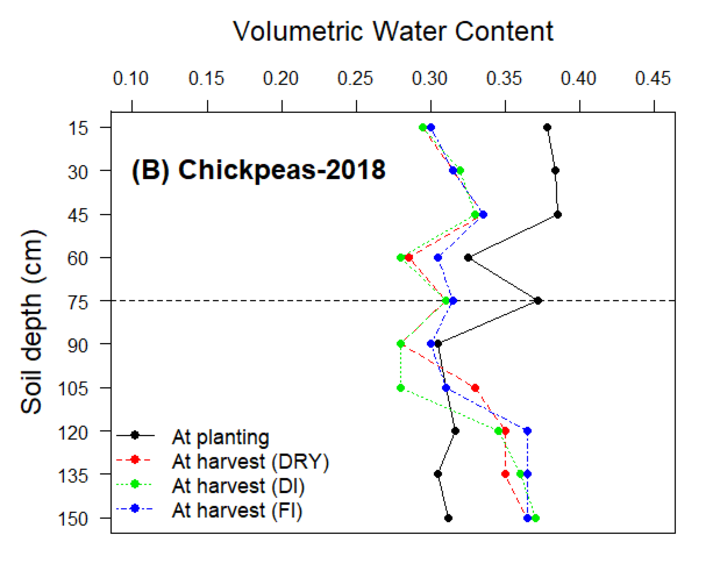
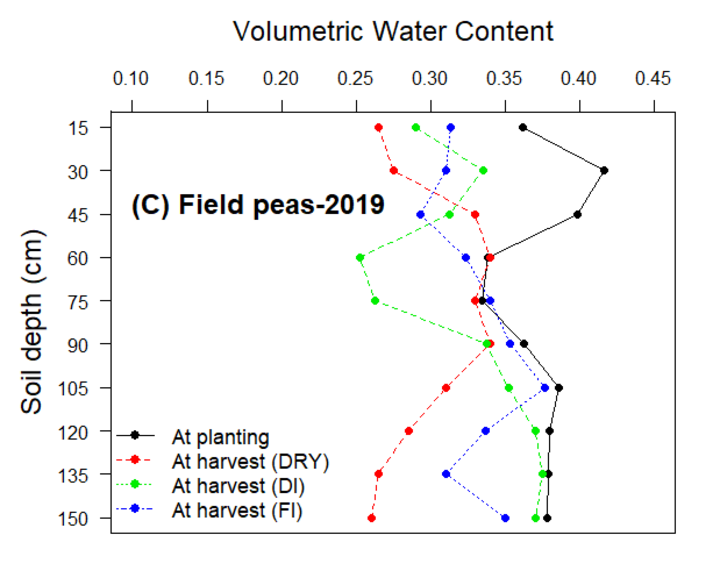

Conclusions
This study highlighted the potential for field peas and chickpeas to be used in limited irrigation cropping systems. Both crops were able to efficiently use early season precipitation and produce very good dryland yields. Field peas showed good response to light irrigation amounts. The potential development of Ascochyta blight also should be considered when deciding to irrigate chickpeas as disease can be devastating to the crop. (See Ascochyta Blight of Chickpeas in Nebraska, G1676.) More research is needed to evaluate the response of field peas and chickpeas under drier years.
Between the two crops, field peas had higher CWUE and the ability to extract soil water from deeper in the profile, demonstrating greater potential to be used under limited irrigation. Field peas, due to the shorter season, also have an advantage over chickpeas in terms of opportunities to double crop forages and/or cover crops and gain additional income.
Acknowledgements
Our thanks to the Nebraska Environmental Trust who provided financial support for this research and to Justin Richardson, the technician assisting with this project.

